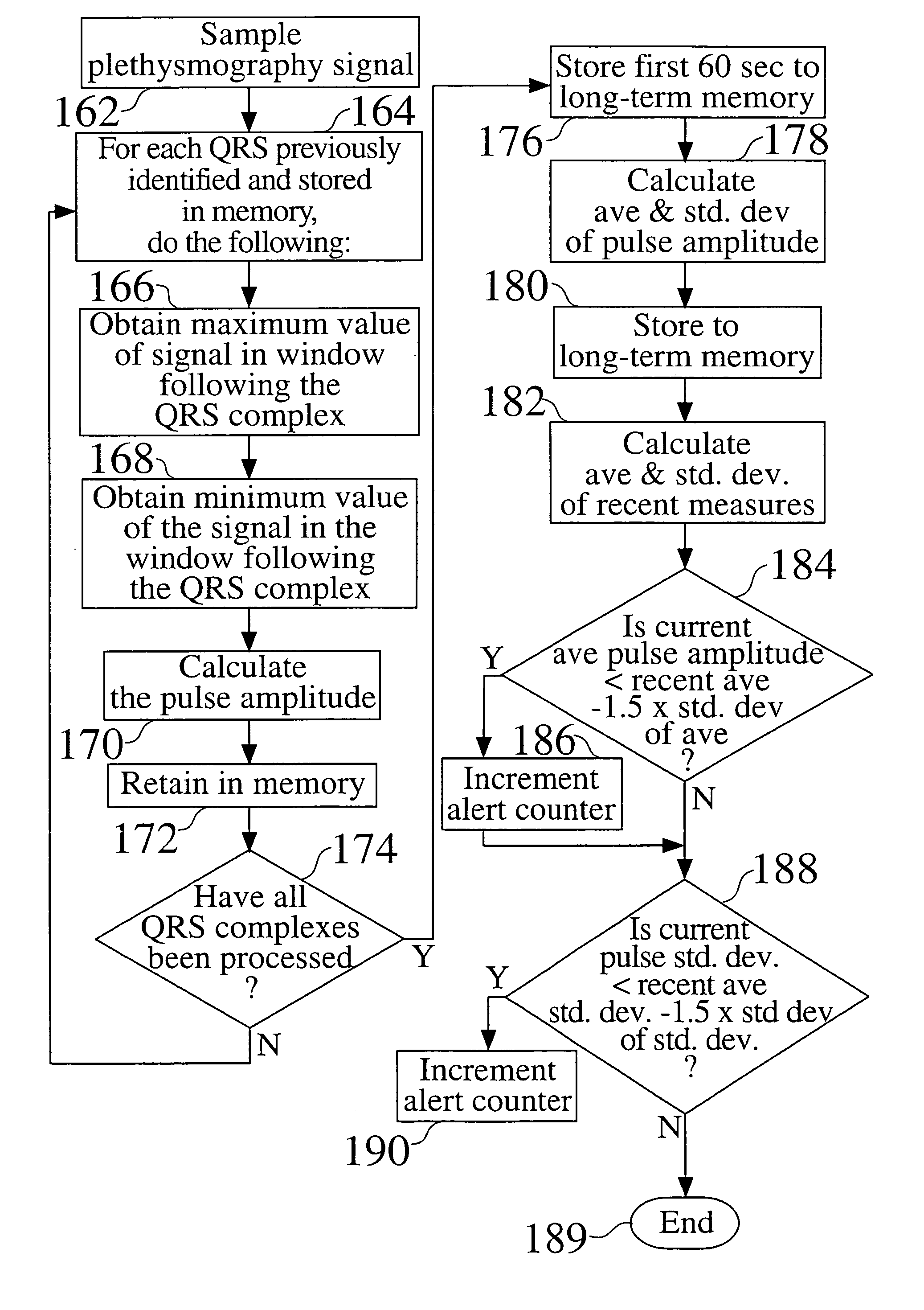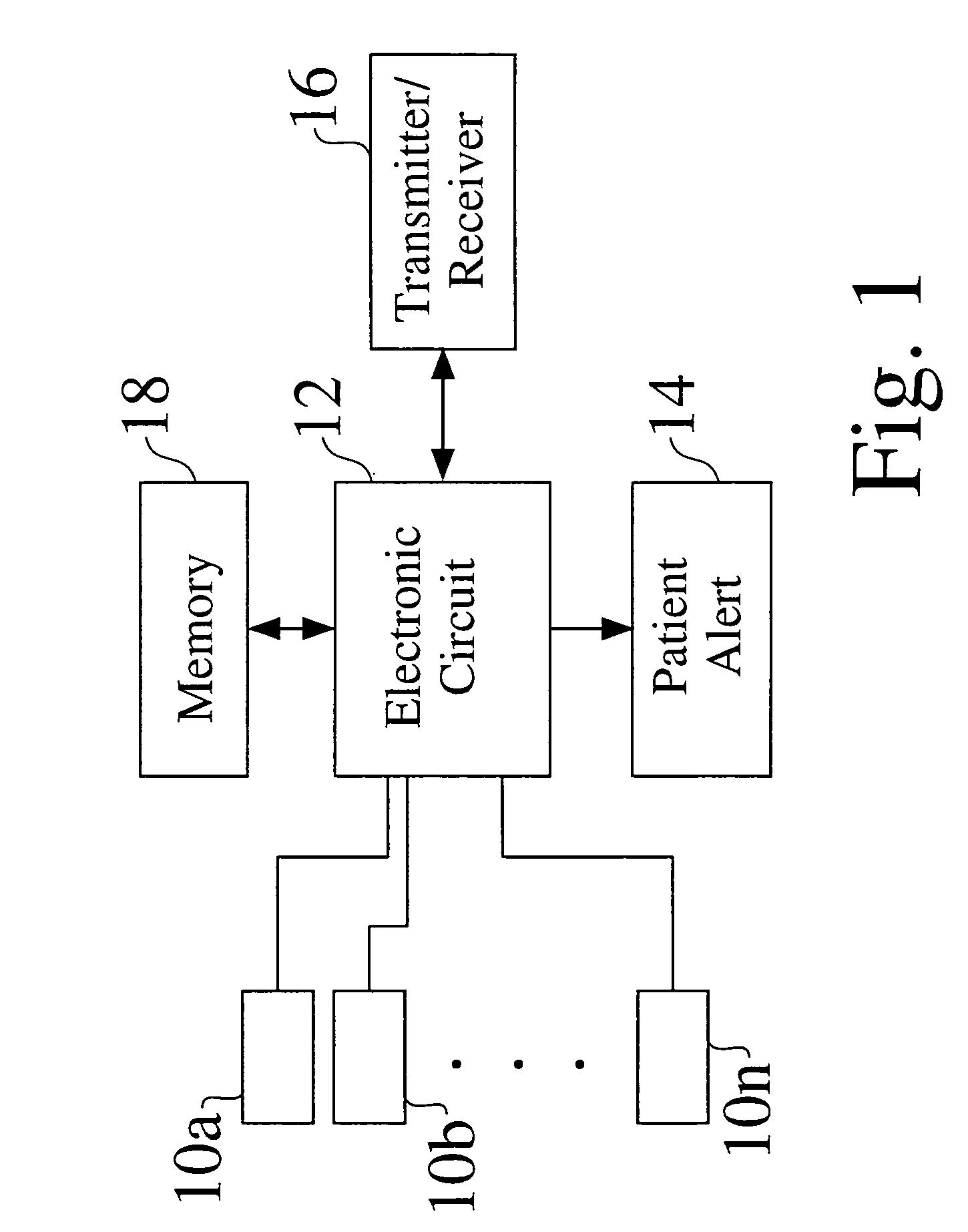This conventional approach of periodic follow-up is unsatisfactory for some diseases, such as heart failure, in which acute, life-threatening exacerbations can develop between physician follow-up examinations.
However, if it develops beyond the
initial phase, an acute heart failure
exacerbation becomes difficult to control and terminate.
It is often difficult for patients to subjectively recognize a developing
exacerbation, despite the presence of numerous physical signs that would allow a physician to readily detect it.
Furthermore, since exacerbations typically develop over hours to days, even frequently scheduled routine follow-up with a physician cannot effectively detect most developing exacerbations.
However, both the amount and the sophistication of the objective physiological data that can be acquired in this way are quite limited, which consequently limits the accuracy of the
system.
Furthermore, intravascular
instrumentation can only be performed by extensively trained specialists, thereby limiting the availability of qualified physicians capable of implanting the device, and increasing the cost of the procedure.
Finally, because of the added patient risks and greater physical demands of an intravascular environment, the intravascular placement of the sensor increases the cost of development, manufacturing, clinical trials, and regulatory approval.
Both these approaches require surface contact electrodes which are cumbersome and inconvenient for the patient, and more susceptible to motion artifact than an implanted
electrode.
Thus the Reveal is intended for short-term recording for diagnostic use, is limited to recording the electrical activity of the heart, and does not attempt to measure or quantify the hemodynamic status of the patient beyond screening for cardiac arrhythmias.
While the Holter monitor recorder, the Reveal Insertable Loop Recorder, and the Implantable
Ambulatory Electrocardiogram Monitor provide important clinical utility in recording and monitoring cardiac electrical activity, none is designed to monitor hemodynamic status.
Indeed, cardiac electrical activity does not, by itself, provide unambiguous information about hemodynamic status.
By sensing only cardiac electrical activity, these devices are unable to distinguish between, for example, a hemodynamically stable cardiac
rhythm and Pulseless Electrical Activity (PEA), a condition in which the heart is depolarizing normally, and thus generating a normal
electrical pattern, but is not pumping blood.
Furthermore, these devices are unable to recognize or quantify subtle changes in the patient's hemodynamic status.
The technical challenge is made more difficult by the greatly increased circumference, relative to that of standard feed-through connections known in the art, of the boundary between the window and the device housing.
While this is an obvious solution for devices that have external leads requiring headers, it presupposes the existence of a header, and therefore does not address the implantable device that lacks a header.
Furthermore, while appending a header to one end or pole of an implantable device is an efficient solution when external leads are required, appending a header-like sensor unit to one end or pole of a device not otherwise requiring a header, where the sensor unit is itself, like a header, the full-thickness of the device, is an inefficient use of volume.
Thus, the approach of Prutchi et al. used in a device that doesn't otherwise require a header would be to
append a header or a header-like sensor unit to one end or pole of the device, but this would unnecessarily increase both the volume and the expense of the device.
For example, the performance of the optical sensor described in the above referenced U.S. Pat. No. 5,556,421 would be so severely degraded by direct transmission of light from source to
detector that one skilled in the art would question the functionality of the proposed solution.
In addition, placement in a rigid
epoxy header is simply not an option for some sensors, such as sound sensors, because of the dramatic degradation in the signal-to-
noise ratio the rigid header would impose.
While the leadless embodiment is desirable for the reasons described by Nolan et al., the technical challenges associated with inferring useful physiologic information from changes in impedance is obvious to one skilled in the art.
The general problem is that the large number of
confounding factors, e.g., changes in
body position, would certainly
swamp the subtle impedance changes that might result from changes in cardiac volume with contraction.
Another aspect of the prior art that has been limited is in the communication of information between a device and the clinician.
However, this
system is intended for short term use to monitor patients who may be subject to sudden life threatening arrhythmic events.
One of the challenges of providing
telemetry at a distance is to provide for the efficient transmission and reception of energy by the
implanted device.
However, like the conventional magnetic coil, the RF antenna is placed within the device housing, which has the undesirable effect of attenuating the
signal strength.
The configuration is desirable in that attenuation by the metallic housing of the device is avoided, however, it requires subcutaneous tunneling for placement, which causes
tissue trauma and increases the risk, both acute and chronic, of infection.
However, placement in the header presupposes the existence of external leads requiring a header, which are not necessarily present in a device that uses extravascular sensors.
 Login to View More
Login to View More  Login to View More
Login to View More 


